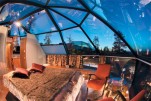Multifunctional Glass with Electric Heating

Modern high-rise buildings have big areas of glazing. However, climatic conditions in northern countries put a question about efficiency of such constructions. That is why we suggest considering three main aspects of application of electrically heated glass. This article covers glass roofs and possible advantages from the usage of electrically heated glass as a way of struggling with accumulated snow, its application as a source of heating in room and energy efficiency of such a solution. Besides, we will explore this given type of glass as a factor of struggling with sweating on the inner surface of glass units, for example in spray rooms.
Electrically heated glass in roofing constructions
So, let us consider some typical technical problems which can arise in a glazed building during the heating season, such as: heating losses, accumulation of snow and sweating. When glazing is located horizontally or almost horizontally accumulation of snow on the glazed roof can cause serious problems which can be removed by an appropriate construction and a proper technical solution. One of the most economically efficient and safe variants is the usage of ELGAS glass units with electrical heating.
Energy efficiency of the roof of the atrium during the heating season
In spite of increase in prices on heat energy and requirements of building specifications and rules of structural glazing, in accordance to which in heated rooms translucent roofing must consist of double-chamber glass units, many objects now still use monolocular glass units which may be applied only at gazing of non-heated rooms.
As glazing from monolocular glass units lets pass (lose) significantly more heat energy during the heating season than double-chamber one, it is important that people who design roofs of atriums and those who are going to pay for the heating of a building understand this difference in energy consumption while using monolocular anf double-chamber glass units in the long-term prospect.
For this we provide comparison of energy consumption of maintenance of the room of the atrium with the area of 1000 sq m during the heating season with application of monolocular and double-chamber glass units. Accounts show that at the cost of energy of 0,10 € / (kWth) during the period of 30 years in the northern countries to heat the roof of the atrium made of monolocular glass units it will require 250 000 € more than the similar glazed by doublechamber ones. It is necessary to take into account that this difference can be even higher as the price of the heat energy continues growing.
Full content of this issue you can read here
The full version of the article can be read in our printed issue, also you can subscribe to the web-version of the magazine
 Text: Timo Saukko, Lauri Leinonen, Kirill Zuevsky,
Text: Timo Saukko, Lauri Leinonen, Kirill Zuevsky,
Saint-Goban Glass Finland Oy


